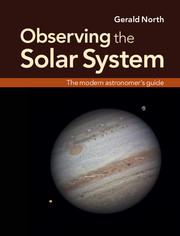Book contents
- Frontmatter
- Contents
- Preface
- Acknowledgements
- Chapter 1 Earth and sky
- Chapter 2 Moon and planet observer's hardware
- Chapter 3 The Solar System framed
- Chapter 4 Stacking up the Solar System
- Chapter 5 Our Moon
- Chapter 6 Mercury and Venus
- Chapter 7 Mars
- Chapter 8 Jupiter
- Chapter 9 Saturn, Uranus and Neptune
- Chapter 10 Small worlds
- Chapter 11 Comets
- Chapter 12 Our daytime star
- Appendix 1 Telescope collimation
- Appendix 2 Field-testing a telescope's optics
- Appendix 3 Polar alignment
- Index
Chapter 1 - Earth and sky
Published online by Cambridge University Press: 05 November 2012
- Frontmatter
- Contents
- Preface
- Acknowledgements
- Chapter 1 Earth and sky
- Chapter 2 Moon and planet observer's hardware
- Chapter 3 The Solar System framed
- Chapter 4 Stacking up the Solar System
- Chapter 5 Our Moon
- Chapter 6 Mercury and Venus
- Chapter 7 Mars
- Chapter 8 Jupiter
- Chapter 9 Saturn, Uranus and Neptune
- Chapter 10 Small worlds
- Chapter 11 Comets
- Chapter 12 Our daytime star
- Appendix 1 Telescope collimation
- Appendix 2 Field-testing a telescope's optics
- Appendix 3 Polar alignment
- Index
Summary
Almost all of this book is devoted to the practical methods we astronomers can use to study the great worlds and other celestial bodies in our Solar System we can see across millions of kilometres of space. To help us appreciate those other worlds it is as well to have to hand some basic facts about our own planet. Also there are some aspects of our Solar System we can observe and study without even using a telescope. So, let us begin our explorations right here, with a brief overview of our Earth and the phenomena that we can see and study without any optical aid . . .
PLANET EARTH
The Earth is a rocky globe, 12 800 km in diameter, orbiting the Sun at a mean distance of 150 million km and taking one year to complete one orbit. The Earth is not quite a perfect sphere but is rather an oblate spheroid, its polar diameter being 43 km less than its equatorial diameter. The difference is caused by the forces arising from the daily (technically diurnal) rotation of the planet on its axis.
The Earth is but one of eight major planets that orbit the Sun and they all rely on the Sun as a provider of light and heat. All the planets go round the Sun in the same direction and all keep close to the same plane as they orbit.
- Type
- Chapter
- Information
- Observing the Solar SystemThe Modern Astronomer's Guide, pp. 1 - 32Publisher: Cambridge University PressPrint publication year: 2012



